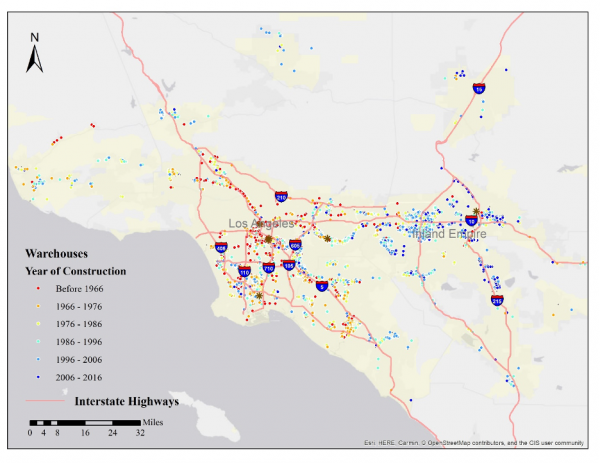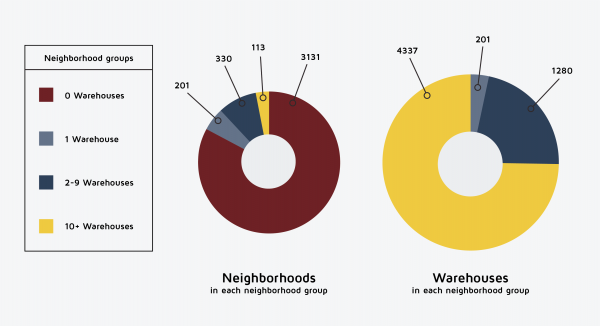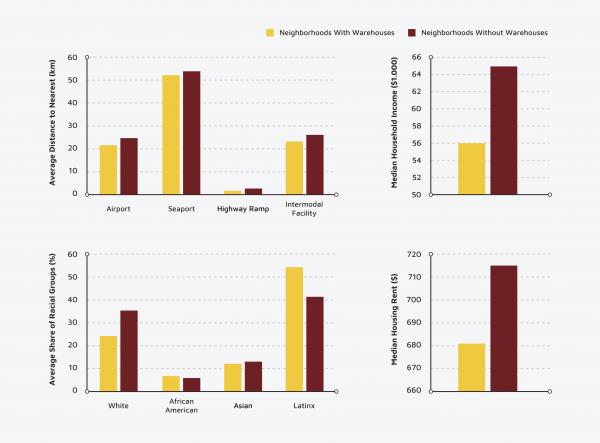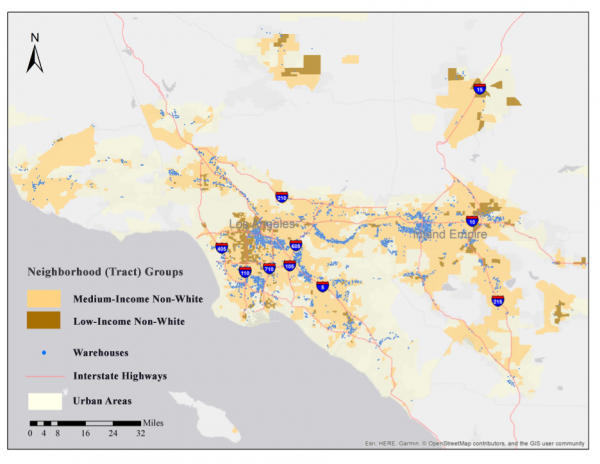
Bearing the Brunt of Expanding E-Commerce: Logistics Sprawl, Goods Movement, and Environmental Justice
Communities of color face disproportionate burdens from living near warehouses
The rapid growth of the logistics industry and online retail in recent decades has substantially increased the volume and frequency of freight flows in U.S. metropolitan areas. Even before the onset of COVID-19, which has pushed more households to online shopping for everything from basic goods to groceries, logistics and online consumption were growing rapidly. But online consumption has a physical component — warehouses and distribution centers — and those were growing rapidly, too. In the Los Angeles region, for example, the number of warehousing facilities increased 29% from 2003 to 2013, 21% in the San Francisco region, and 79% in the Sacramento region. From 2006 to 2016, employment in the warehousing and storage industry in the United States grew by nearly half. During the same period, retail employment grew only 3%, and manufacturing employment actually fell 13%.
Having goods delivered to your door is convenient. Having the warehouse that holds all those goods down the street from you is less so. The physical location of the online economy matters. Warehouses are associated with noise, pollution, and road damage; the places that hold warehouses bear some costs so the rest of the region can receive benefits. But relatively few studies have examined what kinds of neighborhoods bear these concentrated burdens. Mounting evidence suggests, however, that it is neighborhoods with limited economic and political power that are more likely to host these facilities, while better-connected and better-resourced neighborhoods do not.
The Costs of Logistics Sprawl
“Logistics sprawl” — the spread of warehouses and other shipping facilities to suburbs and exurbs — is a little-noticed consequence of the rise of e-commerce. Logistics sprawl is particularly common in gateway metropolitan areas like Los Angeles and Atlanta (see Figure 1). It occurs because supply-chain management has evolved in a way that gives warehouse providers greater incentives to consolidate and scale their facilities. As a result, new warehouses and distribution centers are larger and require more land. For example, in Greater Los Angeles, the average rentable area of warehouses built between 2007 to 2017 was 140,000 square feet, more than twice as large as those built earlier. Large lot sizes make central city locations more difficult. Land in cities is scarce and expensive, and the chronic traffic congestion common to urban cores snarls the heavy truck traffic warehouses need. As a result, warehouses sprawl.

Land in cities is scarce and expensive, and the chronic traffic congestion common to urban cores snarls the heavy truck traffic warehouses need. As a result, warehouses sprawl.

Figure 1. Warehousing facilities by year of construction in the Los Angeles region

Source: Costar Group Inc. (2017)
The increased presence of warehouses can have major impacts on the suburbs where they arrive. As major intermediate components of supply chains, warehouses generate a lot of truck trips. The average warehouse in the Inland Empire, one of Southern California’s suburban warehousing hotspots, generates between 15 and 30 truck trips per day. Larger warehouses generate much more. One study suggests that warehouses create 0.33 to 0.66 trips per 1,000 square feet, which means that 500,000-square-foot warehouses popping up on the suburban fringes of many metropolitan areas can produce as many as 300 truck trips per day through adjacent communities.
By one estimate, moreover, large trucks with five or more axles make more than two-thirds of these trips and disproportionately contribute to noise and air pollution. In California, heavy-duty vehicles account for 90% of the diesel particulate (PM10) emissions, 17% of sulfur dioxide (SO2) emissions, and 53% of nitrogen oxide (NOx) emissions from all on-road sources. These emissions can cause myriad health problems. The Environmental Protection Agency has listed more than 40 diesel exhaust components as hazardous air pollutants, many of which increase cancer risk. Public health studies have found relationships between various adverse health outcomes — such as asthma and respiratory allergies — and exposure to PM10, SO2, NOx, and other truck-related emissions, especially in areas with high densities of truck routes.

Public health studies have found relationships between various adverse health outcomes — such as asthma and respiratory allergies — and exposure to truck-related emissions, especially in areas with high densities of truck routes.

Apart from air pollution, trucks also damage pavement and increase traffic collisions. They are loud: One truck can generate noise equivalent to 22 automobiles. Large warehouse facilities also have lots of pavement, meaning they tend to absorb heat and deflect rainwater, exacerbating urban heat islands and increasing stormwater runoff.
While some of these costs occur throughout the region, as trucks move from warehouses to urban centers and back, they are costs borne most heavily by adjacent communities. It is thus important to know which communities tend to host these facilities: The location of logistics sprawl has important implications for environmental justice.
What do Neighborhoods Near Warehouses Look Like?
Most neighborhoods do not have warehouses, but a small number of places with warehouses have a lot of them. Figure 2 shows the distribution of warehouses in Greater Los Angeles, the second-largest metropolitan area and the largest trade gateway in the United States. Most of the region’s warehouses are located in a relatively small number of neighborhoods. The region’s 5,818 warehouses are unevenly distributed across its 3,775 neighborhoods. While 83% of neighborhoods have no warehouses, 3% have at least 10 warehouses. This 3% of LA’s neighborhoods house 75% of the region’s warehouses.
Figure 2. Distribution of warehouses in the neighborhoods in the Los Angeles region

Figure 3 shows that poorer neighborhoods and those with substantial Latinx populations are more likely to have warehouses, as are places with lower land values and good transportation access.
Figure 3. Socioeconomic characteristics of neighborhoods with and without warehouses

Environmental Inequity in Warehousing Location: A Statistical Analysis
To better understand the relationship between warehouse location and low-income households and communities of color, I divided neighborhoods in Greater Los Angeles into six categories: high-, medium- and low-income white neighborhoods and high-, medium- and low-income neighborhoods of color. I then used statistical analysis to measure the likelihood that these places would host warehousing facilities.
The results suggest that warehouses are disproportionately located in communities of color, especially in Latino neighborhoods. Both low- and medium-income neighborhoods home to communities of color have significantly more warehouses, and higher concentrations of warehousing space, than do medium-income white neighborhoods (see Figure 4). These results are consistent with many previous environmental justice studies, which found that race/ethnicity, not socioeconomic status, is most strongly associated with environmental inequities.
Within neighborhoods of color, medium-income areas are more likely to host warehouses than low-income areas. This finding may be surprising. If lower-income areas have cheaper land than most other neighborhoods, why don’t they attract more warehousing facilities than medium-income neighborhoods? One answer is that lower-income areas don’t always have lower land values. In Central and South Los Angeles, for example, incomes are low but land values are high — at least relative to land values well outside the city. Low-income people are able to live on this high-value land primarily through density: each household consumes relatively little space. And precisely because land values and density are high, these neighborhoods have few of the large, vacant parcels that today’s warehouse developers look for. They also suffer from high levels of traffic congestion.
The medium-income neighborhoods of outlying areas, in contrast, are different. People with slightly more money buy their way out of dense places and purchase more space where land is cheaper. That same abundance of space and cheap land, however, creates a landscape that is appealing to warehouse developers who want large parcels and less congestion. Many middle-income neighborhoods in the Inland Empire offer large parcels, affordable land, good regional access, and favorable local land use policies. These factors mean that they will probably remain popular among warehouse developers in the near future.
Figure 4. Spatial distribution of warehouses and neighborhoods by income and race/ethnicity

Source: Costar Group Inc. (2017); US Census Bureau (2015)
Social and institutional factors may also help explain the racial/ethnic inequities in warehouse location. Zoning, in particular, may have a long-term and salient effect on both the distribution of warehousing facilities and the characteristics of the local residents who live near them. For one, existing industrial zoning tends not to change over time and Greater Los Angeles has a high variation in the amount of land zoned for warehouses. Such historic conditions likely explain why some low-income neighborhoods are largely free from warehouses, while their medium-income neighbors are not.
Finally, warehouses hire mostly blue-collar workers, many of whom live in medium-income neighborhoods. Thus, proximity to labor may be another reason that warehousing developers have chosen to locate in medium-income neighborhoods, and may also explain why some people choose to live near warehouses.
Think ahead and take action
The local impacts of warehousing and logistics are unequally distributed, which raises troubling environmental justice questions. However, local and regional governments have the power to ease this burden off of low-income areas and those that are home to communities of color. Warehouse location is not purely market-driven; both land use path-dependency and local land use and transportation policy exert substantial influence as well. Through land use, building, and environmental regulations, governments can attract or discourage warehouse development. These policies can be used to promote economic growth, and to maintain a fair socioeconomic and racial distribution of that growth’s environmental costs.
The varying warehousing burdens across racial/ethnic communities are a regional problem, meaning governments above the local level should be involved in finding solutions. Regional leadership could help local governments develop consistent standards for regulating and mitigating warehousing and logistics-related externalities. State governments and regional planning agencies can track both the environmental impacts of warehousing and logistics activities and the spatial distribution of these impacts. They can also guide local authorities to mitigate these impacts. Officials at all levels of government can help foster better communication among stakeholders to discuss and develop solutions to environmental equity problems. These stakeholders should include not only warehousing and goods movement interests, but also community groups (especially those representing the racial/ethnic and low-income communities disproportionately affected), environmental organizations, and public agencies. Including voices from these underrepresented perspectives in regional logistics policymaking is essential.

The varying warehousing burdens across racial/ethnic communities are a regional problem, meaning governments above the local level should be involved in finding solutions.

While freight hauling is an important part of transportation — and central to the economy — it creates environmental and health problems, and those problems will grow as e-commerce continues to become more widespread. As the popularity of online ordering and other related services continues to grow, transportation and environmental policy must address warehousing and logistics locations and impacts to influence how and where the booming industry grows — and who exactly bears its effects.